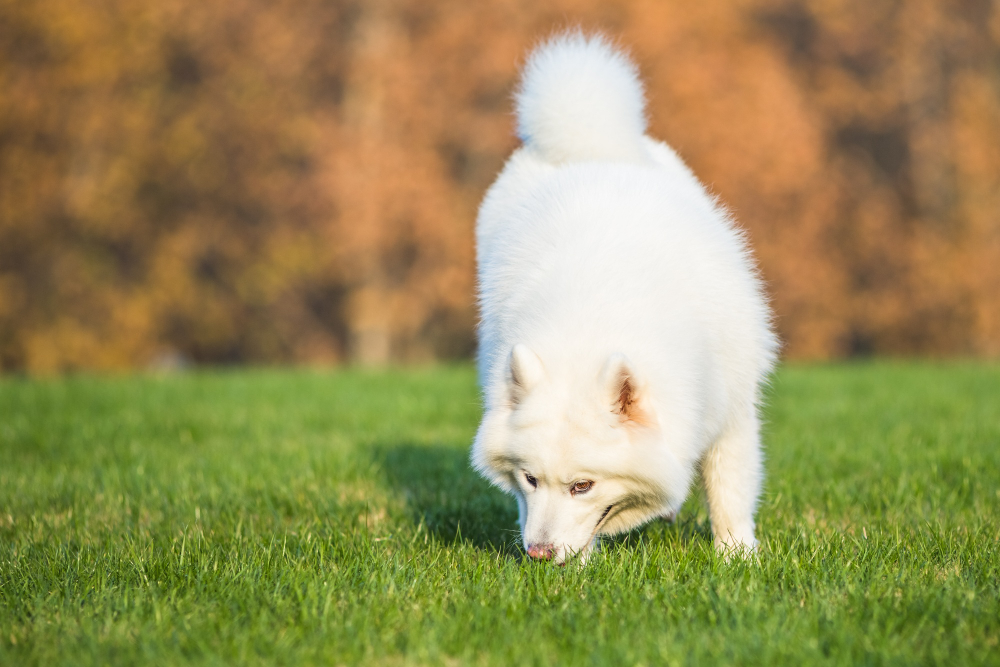Contrary to popular belief, dogs are not strictly carnivorous. They belong to the Carnivora Order, but this does not necessarily mean they only consume meat. A prime example of this is the panda bear, a member of the Carnivora Order that primarily feeds on bamboo shoots and leaves. Dogs, like pandas, are omnivores, meaning they can consume both animal and plant-based foods. This is evident in their anatomy, behavior, and food preferences. For instance, dogs possess molar teeth with flat surfaces, designed for grinding food and fibrous materials, a characteristic not found in carnivores.
The Grass-Eating Habit
It’s a common sight to see dogs munching on grass during walks, sometimes to the point of vomiting. But why do dogs eat grass? Is it because they are carnivores seeking plant-based food, or does it serve another purpose? Let’s delve into this further.
Composition of Grass
Grass, or grams, come in various species and are primarily composed of carbohydrates (soluble and insoluble fibers), with minor amounts of proteins, fats, minerals, and vitamins. In a dog’s diet, fibers play a crucial role in promoting intestinal health. Soluble fibers increase satiety, while insoluble fibers act as prebiotics and enhance intestinal flow. However, the amount of grass a dog consumes is usually too small to significantly contribute to their dietary fiber intake.
Reasons for Grass Consumption
Dogs are attracted to grass due to its color and smell. However, the consumption of grass is often linked to a primitive instinct inherited from their ancestors. Grass is associated with alleviating gastrointestinal discomforts such as flatulence, stomach pain, intestinal cramps, dry stools, and diarrhea. In essence, grass acts as a “cleaner” for a dog’s digestive system.
Nutritional deficiencies can also prompt a dog to consume grass. When a dog is hungry, it may seek any available food source to satisfy its hunger. Emotional factors like anxiety, stress, and boredom can also increase the frequency of grass consumption.
Grass ingestion can also be a form of entertainment for dogs. Therefore, it’s important to monitor your dog during walks. If you notice your dog frequently eating grass and vomiting, it’s crucial to consult a veterinarian to rule out any underlying health issues. While there are no strict restrictions on grass intake, it’s important to be vigilant, especially if the grass is not from your own backyard.
Warning Signs Related to Grass Ingestion
Occasional grass consumption in small amounts is generally not a cause for concern. However, frequent and excessive grass consumption may indicate underlying health issues. Signs to look out for include:
- Apathy: The dog becomes uninterested and disengaged from its surroundings.
- Diarrhea: This could be caused by sudden changes in diet, ingestion of foreign objects, unfamiliar food, bacterial or viral infections, or parasitic infestations.
- Loss of Appetite: A decrease in appetite is often an early warning sign of health issues.
- Fever: A dog’s normal body temperature ranges between 37.5°C and 39.3°C. Anything above this range indicates a fever.
Potential Risks of Grass Ingestion
Grass ingestion can potentially lead to parasitic infestations, as dogs often consume grass from public spaces like parks, which are frequented by other dogs. These areas may contain fecal matter from other dogs, which could harbor parasitic eggs.
Additionally, other plants growing alongside grass could be toxic and cause irritation or food poisoning. Choking is also a risk, as some types of grass are thin and long. In severe choking cases, the Heimlich maneuver may be necessary to clear the dog’s airway.
Should Grass Be Included in a Dog’s Diet?
While grass can be used for environmental enrichment, there is no need to include it in a dog’s daily diet. Pet stores often sell dog-friendly grass that can be kept at home for your dog to interact with.
How to Discourage Grass Eating
If you’re uncomfortable with your dog eating grass and wish to discourage this behavior, the first step is to consult a veterinarian to rule out any health issues associated with this behavior.
If a nutritional deficiency is identified, dietary modifications may be recommended to satisfy your dog’s nutritional needs, reducing its attraction to grass. Similarly, dogs with behavioral issues such as anxiety and stress may decrease their grass consumption with changes to their routine and the inclusion of daily exercise.
It’s important to note that grass consumption is an instinctual behavior inherited from their ancestors, so some changes may only reduce, not completely eliminate, grass intake. Therefore, it’s recommended to follow the vaccination and deworming protocols established by your country.
Conclusion: Understanding and Managing Your Dog’s Grass Eating Behavior
In conclusion, dogs are omnivores capable of consuming both plant and animal-based foods. The habit of eating grass is a common behavior in dogs, often linked to their ancestral instincts. While it can serve as a means to alleviate gastrointestinal discomfort or act as a form of entertainment, it’s crucial to monitor this behavior closely as it can also indicate underlying health issues or nutritional deficiencies.
Grass consumption in moderation is generally harmless, but excessive intake can potentially lead to health risks such as parasitic infestations, choking, or ingestion of toxic plants. If you notice your dog frequently eating grass and exhibiting signs of discomfort or illness, it’s essential to consult with a veterinarian.
While it’s possible to discourage grass eating through dietary modifications and behavioral changes, completely eliminating this instinctual behavior may not be feasible. Therefore, maintaining regular vaccination and deworming schedules is vital to ensure your dog’s health and wellbeing.
Understanding your dog’s behavior and dietary habits is an integral part of responsible pet ownership. By staying informed and vigilant, you can ensure your furry friend leads a healthy, happy, and fulfilling life.

